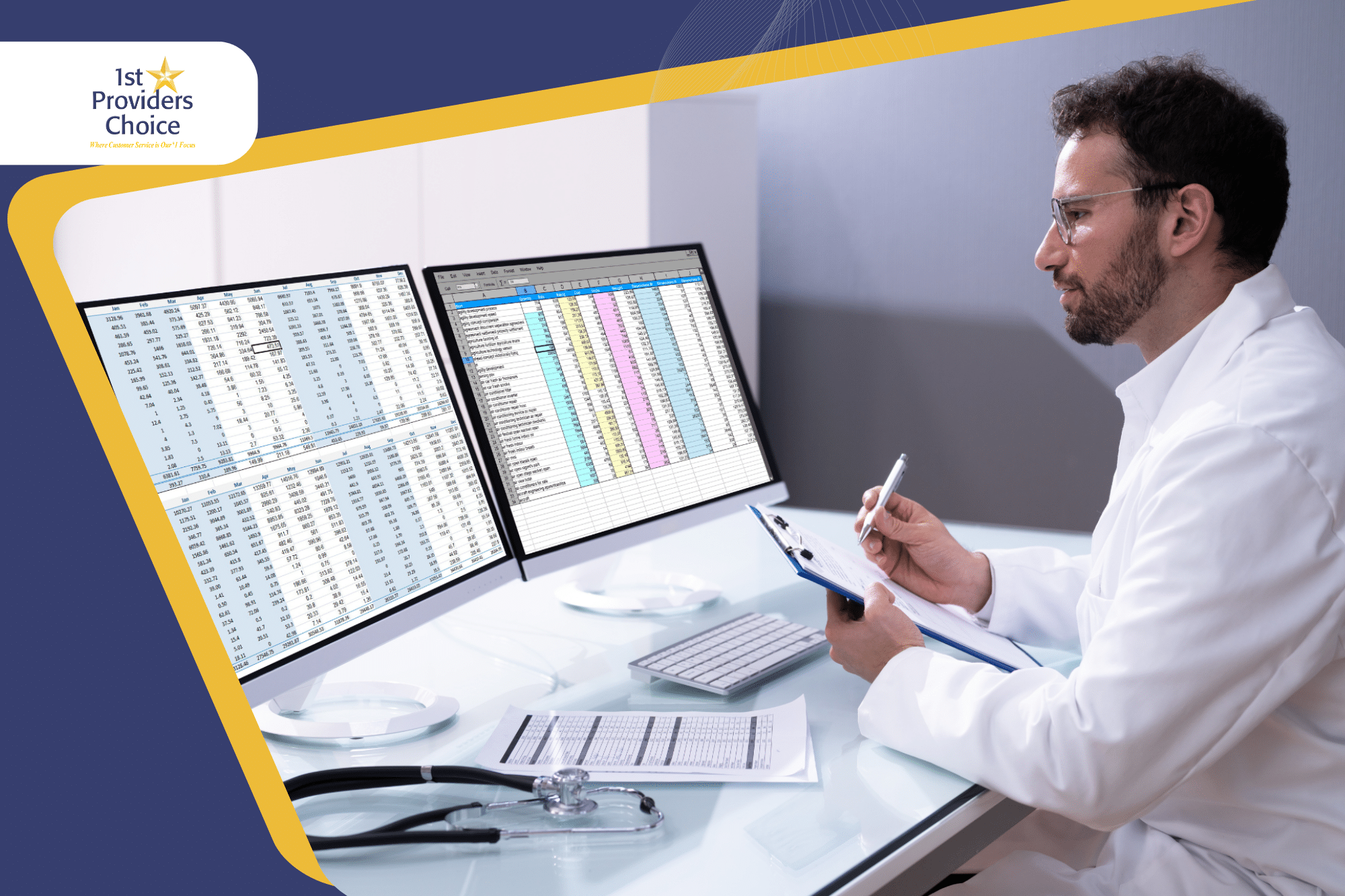Physician’s Guide to the 2026 Medicare Billing Payments

Good news is on the horizon for physicians: The Centers for Medicare & Medicaid Services (CMS) has announced a projected increase in Medicare payments for 2026.
After years of flat or declining reimbursement rates, this change offers a much-needed boost for providers, especially those on the front lines of primary and specialty care.
While the final numbers are still pending, this update could positively impact practice revenue, documentation habits, and even long-term care strategies. When you have EMR/EHR solutions like 1st Providers Choice, you can stay on top of 2026 Medicare billing updates and better position yourself to make the most of this upcoming shift.
Get Ready for 2026
Optimize Your Medicare Billing Today
What’s behind the 2026 Payment Increase?
For years, the goal has been to better align physician payment with economic realities, improve the long-term sustainability of practices, and prevent burnout and staffing shortages across the healthcare system.
So, what’s fueling this 2026 Medicare billing update?
- MACRA’s Continued Evolution
The Medicare Access and CHIP Reauthorization (MACRA) continues to shift focus from volume to value. This payment increase reflects ongoing policy momentum toward supporting practices that provide high-quality, cost-efficient care.
- Adjusting for Inflation with MEI
For the first time, the 2026 conversion factor will reflect the full Medicare Economic Index (MEI), which accounts for rising practice costs like staffing, rent, and supplies. It’s a long-overdue correction aimed at better keeping up with inflation.
- A Nudge Towards Value-Based Care
Lawmakers intend to encourage more providers to participate in the Merit-based Incentive Payment System (MIPS) or Advanced Alternative Payment Models (APMs) through higher payments. These value-based models reward outcomes, and this increase is one more lever to accelerate adoption.
- Congressional Influence
Facing increasing pressure to stabilize physician payments and improve access—particularly in rural and underserved areas—lawmakers took initial steps through the Consolidated Appropriations Act of 2023.
Who Will Benefit the Most?
While physician Medicare payment increases, the impact is not the same for every provider. Some groups stand to benefit more than others, especially those already working in high-need areas or participating in value-driven care models.
Primary Care Gets Priority
CMS knows that primary care physicians are at the heart of patient care. In 2026, they expect to see one of the biggest boosts (especially those serving older or medically complex populations) so they can continue to support proactive, preventive care.
Rural and Underserved Practices
Providers in Health Professional Shortage Areas (HPSAs) or rural communities may see additional support. These areas often face staffing shortages and fewer resources, so CMS is stepping in with improved reimbursement rates to help close the gap in access to care.
ACOs and Value-Based Care Participants
Incentives for participants in Accountable Care Organizations (ACOs) or APMs are getting stronger. These models prioritize care coordination and quality outcomes, which CMS highly values and is likely to support with higher performance-based payments.
How Much Will Medicare Pay Physicians in 2026?
While the final numbers are undergoing fine-tuning, here’s what we know so far:
2.5% Estimated Increase
The headline figure is a 2.5% overall boost in the Medicare physician fee schedule. However, this is a temporary adjustment, subject to CMS’s final rule, which is expected later this year. Given ongoing policy shifts, the exact percentage could vary.
Updated Conversion Factors
As part of its Medicare Physician Fee Schedule, here’s how the proposed 2026 conversion factors compare to this year’s:
| Physician Category | 2025 (Current) | 2026 (Proposed) | Approx. Change |
| Non-Qualifying Physicians | $32.3465 | $33.4209 | +$1.0744 (+3.32%) |
| Advanced Alternative Payment Model (APM) Qualifiers | $32.3465 | $33.5875 | +$1.2410 (+3.83%) |
| Anesthesia Nonqualifying Physicians | $20.3178 | $20.5728 | +$0.2550 |
| Anesthesia Qualifiers | $20.3178 | $20.6754 | +$0.3576 |
Source: AMA
Note: Conversion factors are expressed in dollars because they represent how much Medicare pays per Relative Value Unit (RVU).
RVUs, Adjustments & Specialty Impacts
Alongside the conversion factor updates, CMS is proposing:
- A -2.5% efficiency adjustment to work RVUs for certain non-time-based services, like surgeries or diagnostics.
- A +0.55% adjustment to maintain budget neutrality due to code revaluations.
What does that mean? While headline rates are going up, the value of some procedures may drop. On the other hand, practices focusing on telehealth, E/M services, or behavioral health may see net gains.
| Actual payment changes will vary based on specialty, geography, reporting status (e.g., MIPS or APM), and performance. Final figures are subject to CMS’s official rulemaking later this year. |
What This Means for Your Practice Revenue Cycle
A 2.5% bump in Medicare payments may sound modest, but it does affect your bottom line, especially when combined with strategic improvements in your billing process. Here’s how to make sure your practice captures every dollar:
Accurate Documentation = Higher Reimbursement
Whether or not payment changes, your revenue depends on the quality of your documentation. With the new 2026 coding rules and updated conversion factors, missing small details can cost your practice thousands.
Stay Ahead of Coding & Billing Changes
2026 brings revalued codes and adjustments that affect how services are billed. Take note of CMS updates and partner with a trusted billing or EHR provider that keeps your system current and compliant.
Leverage Your EHR for Efficiency
The right EHR system can help your practice:
- Auto-update to the latest CPT and CMS rules.
- Flag undercoded or unbilled services.
- Reduce rejected claims.
- Generate audit-ready documentation.
Invest in Growth Opportunities
With increased payment potential, 2026 is a great time to:
- Expand into telehealth, especially for mental health and chronic care.
- Streamline admin tasks with automation tools.
- Launch or grow remote patient monitoring (RPM) or chronic care management (CCM) programs.
Let 1st Providers Choice Help You Maximize the Opportunity

With the new changes in 2026, you’ll need a trusted partner, the right EHR, and a practice management system that thrives despite the changes.
When the rules shift, practices using 1st Providers Choice don’t fall behind. With over 40 years of experience, we know how to turn Medicare complexity into practice profitability. With our EHR/EMR solutions, you’re positioning your practice to reap the maximum benefits of the 2026 Medicare billing updates.
Smarter RCM for Medicare Workflows
Our RCM tools are designed with Medicare reimbursement 2026 rules in mind, helping you:
- Identify undercoded visits
- Automate modifier use
- Ensure faster, cleaner submission
Built-In MIPS & APM Tracking
Our EHR comes with built-in MIS/APM tracking, allowing you to:
- Monitor your performance thresholds
- Catch gaps in reporting early
- Avoid penalties and unlock incentives
Always Compliant, Always Current
Our team ensures your system is always:
- Up-to-date with new CPT and HCPCS codes
- Aligned with the latest CMS billing guidelines
- Ready for audits with traceable documentation
Start preparing today. Let’s schedule a revenue optimization analysis and show you what 1st Providers Choice can do for you. The earlier you align your billing and EHR strategies, the better positioned you’ll be to capture every dollar.
Turn Policy Changes into Profit
Thrive with 1st Providers Choice
Frequently Asked Questions
- When will CMS release the final 2026 Medicare payment rule?
CMS typically releases the final Medicare Physician Fee Schedule (MPFS) rule in November, so providers should stay alert in late fall 2025 for the confirmed rates and policy details. - How can I find out how these changes will affect my specialty or region?
The best way is to use CMS’s final rule documentation or consult your EHR analytics dashboard to model the impact based on your billing history, codes used, and location-specific data. - What happens in 2027? Will this payment increase stick around?
Unfortunately, no. The 2.5% boost is temporary and limited to 2026. Unless further legislation is passed, 2027 may see a return to lower conversion factors or potential cuts. - Can I still join an APM or improve my MIPS score to boost payments?
Yes! Participation in APMs or improving your MIPS performance can lead to bonus payments and higher reimbursements. Your EHR vendor or RCM partner can help you strategize before the next performance year begins.

